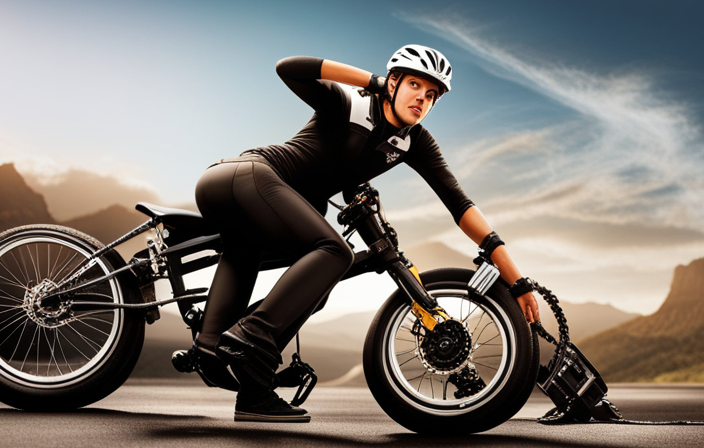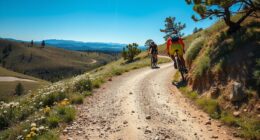Picture this: you’re cruising down the streets, feeling the wind in your hair and the exhilaration of an electric bike powering your journey.
But as the battery indicator starts to dwindle, you wonder: how long will it take to charge it back up?
In this article, we delve into the intricacies of charging an electric bike battery. From factors affecting charging time to fast charging options and tips for extending battery life, we’ve got you covered.
So, let’s dive in and uncover the secrets of efficient charging for your electric steed.
Key Takeaways
- Battery capacity affects charging time, with larger capacity batteries taking longer to charge.
- Advancements in technology have led to faster charging options, with some batteries able to be charged to 80% in 2 hours.
- Fast charging options, such as Quick Chargers and Rapid Chargers, significantly reduce charging time.
- While fast charging options offer faster charging rates and reduced charging times, they may slightly impact battery life and generate more heat.
Factors Affecting Charging Time
One of the factors that affects the charging time of an electric bike battery is the capacity of the battery. The capacity refers to the amount of energy that the battery can store.
Generally, batteries with larger capacities take longer to charge compared to those with smaller capacities. However, advancements in technology have led to the development of fast charging options for electric bike batteries. These options utilize higher charging currents and specialized charging algorithms to significantly reduce charging times.
For example, some electric bike batteries can now be charged to 80% capacity in as little as 2 hours. This is a substantial improvement when compared to older batteries that would take 4-6 hours to reach the same level.
With the availability of fast charging options, the charging time of electric bike batteries has significantly decreased. Now let’s explore the average charging time for electric bike batteries.
Average Charging Time for Electric Bike Batteries
On average, it typically requires a certain amount of time to recharge the battery of an e-bike. The charging time for electric bike batteries can vary depending on several factors, including the battery size and the charging method used.
Generally, smaller batteries with lower capacities tend to charge more quickly compared to larger batteries. This is because smaller batteries require less time to reach their full capacity.
Additionally, the charging method used can also impact the charging time. Traditional charging methods may take several hours to fully charge an electric bike battery, while fast charging options can significantly reduce the time required. Fast charging options utilize advanced technologies to deliver higher charging currents, allowing the battery to charge at a much faster rate.
With these faster charging options, you can quickly recharge your electric bike battery and get back on the road in no time.
Fast Charging Options
When it comes to fast charging options for electric bike batteries, there are two key points to consider: Quick Chargers and Rapid Chargers.
Quick Chargers are designed to charge the battery at a faster rate, typically within 2-4 hours.
On the other hand, Rapid Chargers can charge the battery even faster, usually within 1-2 hours, but they require a higher power input.
These options provide efficient and time-saving solutions for those who need their electric bike batteries charged quickly.
Quick Chargers
To charge your electric bike battery quickly, you can use a quick charger. Quick chargers are designed to provide a faster charging rate compared to standard chargers, allowing you to get back on the road in less time.
One of the main benefits of quick charging is the reduced charging time, which can be as little as 1-2 hours depending on the battery capacity. However, it is important to note that quick charging may have a slight impact on the overall battery life. The higher charging rate can generate more heat, which can lead to faster degradation of the battery cells over time.
Nevertheless, if you need a quick boost of power and are willing to sacrifice a bit of battery longevity, a quick charger is a great option.
Moving on to the next section about ‘rapid chargers’, these chargers take fast charging to a whole new level.
Rapid Chargers
If you’re looking to get a rapid charge for your e-bike, rapid chargers offer an even faster charging rate than quick chargers. Here are four key advantages of using a rapid charger for your electric bike battery:
-
Reduced charging time: Rapid chargers can significantly decrease the time it takes to fully charge your e-bike battery. With their high charging power, you can expect a much quicker turnaround compared to regular chargers.
-
Convenient for longer rides: Rapid charging allows you to top up your e-bike battery quickly, making it ideal for riders who need a quick boost before embarking on a long journey.
-
Increased flexibility: Rapid charging provides more flexibility in planning your rides. You can charge your e-bike battery in a shorter amount of time, allowing for more spontaneous trips.
-
Improved productivity: With rapid charging, you can spend less time waiting for your battery to charge and more time enjoying your ride.
While rapid charging offers numerous benefits, it’s important to be aware of the drawbacks. Rapid charging can generate more heat, which may lead to reduced battery lifespan over time. Additionally, the high charging power can put more stress on the battery cells, potentially causing them to degrade faster.
Now that you understand the benefits and drawbacks of rapid charging, let’s move on to some useful charging tips and tricks.
Charging Tips and Tricks
Charging an electric bike battery can be optimized with some helpful tips and tricks. To make the most of your charging process, consider alternative charging methods like using a rapid charger or taking advantage of regenerative braking. These methods can help you charge your battery more quickly and efficiently. Additionally, there are some general tips you can follow to maximize your charging experience. For example, always use the charger provided by the manufacturer to ensure compatibility and safety. It’s also a good idea to charge your battery at room temperature and avoid extreme hot or cold conditions. Lastly, try to avoid charging your battery to 100% capacity every time, as this can put unnecessary stress on the cells and shorten their lifespan. By following these tips, you can ensure a longer battery life for your electric bike. Moving forward to extending battery life, there are additional strategies you can implement to maximize the lifespan of your battery.
Extending Battery Life
To extend the life of your electric bike battery, there are a few key points to keep in mind.
Firstly, avoid overcharging your battery as this can lead to decreased overall capacity and performance.
Secondly, store your battery properly in a cool, dry place to prevent damage from extreme temperatures or moisture.
Lastly, regularly check your battery for any signs of wear or damage and replace it if necessary to ensure optimal performance and longevity.
By following these guidelines, you can maximize the lifespan of your electric bike battery and enjoy many miles of reliable riding.
Avoiding Overcharging
Make sure you don’t overcharge your electric bike battery. Overcharging can significantly reduce its lifespan and performance.
To avoid this, follow these guidelines:
-
Use a charger specifically designed for your electric bike battery. Using a charger with the wrong voltage or current can lead to overcharging.
-
Set a timer or use a smart charger that automatically stops charging when the battery is full.
-
Avoid leaving the battery connected to the charger for extended periods after it reaches full charge.
-
Regularly check the battery’s charge level and disconnect it from the charger once it reaches 100%.
By following these steps, you can ensure that you don’t overcharge your electric bike battery, maximizing its lifespan and performance.
Properly storing your batteries is another important aspect of electric bike battery maintenance.
Storing Batteries Properly
To ensure the longevity and optimal performance of your electric bike battery, it is crucial to store it properly. Battery maintenance is essential, especially when the bike is not in use for an extended period.
When storing the battery, make sure it is in a cool and dry place, away from direct sunlight and extreme temperatures. It is recommended to remove the battery from the bike and store it separately.
Before storage, ensure that the battery is charged to around 50% capacity. This will prevent it from fully discharging, which can lead to irreversible damage. Additionally, check the battery’s voltage every three months and recharge it if necessary to maintain its health.
By following these guidelines, you can prolong the lifespan and performance of your electric bike battery.
Now, let’s move on to regular battery checks and replacements.
Regular Battery Checks and Replacements
Performing regular checks and replacing the battery when necessary is essential for maintaining the optimal performance of your electric bike. Battery maintenance is crucial to ensure the longevity and efficiency of your battery.
Regularly inspect the battery for any signs of damage, such as cracks or leaks, and replace it immediately if needed. Additionally, it is important to monitor the battery capacity by checking the voltage and charge level regularly. This will help you determine when it’s time to replace the battery and avoid any unexpected power failures during your rides.
Now that you understand the importance of regular battery checks and replacements, let’s explore alternative charging methods for your electric bike.
Alternative Charging Methods
When it comes to alternative charging methods for electric bike batteries, there are three key points to consider: solar charging, portable power banks, and regenerative braking.
Solar charging allows you to harness the power of the sun to charge your bike’s battery, providing a sustainable and environmentally friendly solution.
Portable power banks offer a convenient way to charge your battery on the go, allowing you to easily carry an extra power source with you.
Lastly, regenerative braking technology allows the bike to convert the energy generated during braking into usable electrical energy, further extending the battery life.
Solar Charging
You can easily charge your electric bike battery using solar power. Here are three reasons why solar charging is a great option for your electric bike:
-
Solar panel installation: By installing solar panels on your roof or in your yard, you can harness the power of the sun to charge your electric bike. This renewable energy source is not only environmentally friendly but also cost-effective in the long run.
-
Battery capacity optimization: Solar charging allows you to maximize the capacity of your electric bike battery. With a steady supply of solar energy, you can ensure that your battery is always charged to its fullest potential, giving you longer rides without worrying about running out of power.
-
Sustainable and convenient: Solar charging is a sustainable way to power your electric bike, reducing your carbon footprint. Additionally, it offers the convenience of charging your bike whenever and wherever the sun is shining.
By utilizing solar charging, you can optimize your battery capacity and enjoy sustainable, convenient rides.
Moving on, let’s explore the next section about portable power banks.
Portable Power Banks
If you’re on the go and need a reliable backup power source, portable power banks are an essential accessory for your electric bike. These compact and lightweight devices provide a convenient way to charge your electric bike battery while you’re out and about.
Portable power banks are designed to be easily carried in a backpack or mounted onto your bike, allowing you to charge your battery wherever you are. With the advancements in technology, these power banks have become more efficient and can provide a significant amount of charge to your electric bike battery. They are equipped with multiple USB ports and a high-capacity battery, ensuring you have enough power to get you through your ride.
Additionally, some power banks even have solar panels, allowing you to charge them while you’re riding. This makes portable power banks the perfect solution for charging on the go.
Now, let’s move on to the next section about regenerative braking.
Regenerative Braking
Now that you understand the importance of portable power banks for electric bikes, let’s delve into another fascinating aspect of electric bike efficiency: regenerative braking.
This innovative feature allows electric bikes to recover and store energy that is typically lost during braking. When you apply the brakes, the electric motor switches into reverse mode, acting as a generator and converting the kinetic energy of the bike into electrical energy. This energy is then stored in the battery, enhancing its overall capacity and extending the bike’s range.
By harnessing this energy regeneration capability, electric bikes are able to optimize their battery usage and increase their overall efficiency. This means you can go further on a single charge and make the most of your electric bike’s battery capacity.
Now, let’s move on to comparing the charging time of electric bikes with other modes of transportation.
Charging Time Comparison with Other Modes of Transportation
The charging time of an electric bike battery can be compared to other modes of transportation. When it comes to electric car battery charging time, electric bikes have a clear advantage. Here are three reasons why quick chargers are beneficial for electric bikes:
-
Efficiency: Quick chargers for electric bikes can charge the battery in a fraction of the time compared to regular chargers. This means less waiting time and more time on the road.
-
Convenience: Quick chargers are designed to be easily accessible, allowing riders to charge their electric bikes at various locations. This eliminates the need to rely solely on dedicated charging stations.
-
Flexibility: With quick chargers, electric bike riders have the freedom to charge their batteries whenever and wherever they need to, making it a more convenient option for daily commutes or long rides.
As we transition to the next section about charging stations and infrastructure, it’s important to consider the role they play in supporting the growing number of electric bikes on the road.
Charging Stations and Infrastructure
To support your electric bike journeys, it’s important to have a reliable network of charging stations and infrastructure in place. The accessibility of charging stations plays a crucial role in the widespread adoption of electric bikes. Having convenient and easily accessible charging stations increases the convenience and appeal of electric bikes as a mode of transportation.
To illustrate the significance of charging station accessibility, let’s compare it with other modes of transportation in terms of charging time. The table below shows the average charging time required for different modes of transportation:
| Mode of Transportation | Average Charging Time |
|---|---|
| Electric Bike | 2-4 hours |
| Electric Car | 4-8 hours |
| Electric Scooter | 2-3 hours |
| Public Transit | N/A |
| Bicycle | N/A |
As you can see, electric bikes have a relatively shorter charging time compared to electric cars and scooters. This, coupled with the increasing availability of charging stations, makes electric bikes a practical choice for daily commuting.
Looking ahead, future developments in charging technology will further enhance the charging experience for electric bike users. [Sentence transition into the subsequent section about ‘future developments in charging technology’ without writing ‘step’].
Future Developments in Charging Technology
You’ll be pleased to know that advancements in charging technology are on the horizon for electric bikes.
One such development is wireless charging, which eliminates the need for physical connections between the bike and the charging station. This technology utilizes inductive charging, where an electromagnetic field transfers energy between two coils, one in the bike and one in the charging pad.
By simply parking your electric bike on the charging pad, the battery will start charging without the hassle of plugging in any cables. This innovation not only improves convenience but also reduces wear and tear on the charging port.
With wireless charging, the future of electric bike charging is set to be more seamless and user-friendly.
In the next section, we will delve into the conclusion and final thoughts on the topic.
Conclusion and Final Thoughts
In conclusion, the future of charging technology for electric bikes looks promising with advancements like wireless charging on the horizon. This technology will greatly enhance the convenience and efficiency of charging electric bike batteries.
Here are three key points to consider:
-
Wireless charging: With this technology, you’ll be able to charge your electric bike battery simply by parking it on a charging pad, eliminating the need for cables and connectors.
-
Improved charging efficiency: As charging technology continues to develop, we can expect faster charging times and improved energy transfer efficiency. This means you’ll be able to charge your electric bike battery more quickly and efficiently.
-
Impact of battery capacity: As the capacity of electric bike batteries increases, it will become even more important to have efficient charging technology. With advancements in charging technology, you’ll be able to charge higher capacity batteries without sacrificing charging speed or energy efficiency.
Overall, the future of charging technology for electric bike batteries looks bright, with advancements in wireless charging and improved efficiency on the horizon. These developments will greatly enhance the user experience and make electric bikes even more convenient and practical for everyday use.
Frequently Asked Questions
Are electric bike batteries compatible with fast charging options?
Yes, electric bike batteries are compatible with fast charging options. Fast charging benefits include shorter charging times and convenience. However, frequent fast charging may have a slight impact on the battery life over time.
Can I charge my electric bike battery using solar power?
You can harness the power of the mighty sun to charge your electric bike battery at home. Solar power offers numerous advantages, including cost savings, environmental friendliness, and endless energy supply.
How long does it take to fully charge an electric bike battery using alternative charging methods?
Using alternative charging methods, the charging time of an electric bike battery depends on the battery capacity. Higher capacity batteries take longer to charge. It is important to consider the charging time when planning your rides.
Are there any charging stations specifically designed for electric bikes?
Charging infrastructure for electric bikes is growing rapidly. Some cities have dedicated charging stations with fast charging capabilities. Battery capacity also plays a role, as larger batteries may require longer charging times.
What advancements are being made in charging technology for electric bikes?
Advancements in charging technology for electric bikes include the development of wireless charging systems and ultra-fast charging capabilities. These innovations aim to provide convenient and efficient charging solutions for electric bike users, enhancing their overall experience.
Conclusion
In conclusion, the charging time for electric bike batteries can vary depending on several factors such as battery capacity, charger power, and battery health.
On average, it takes around 4-6 hours to fully charge an electric bike battery. While this may seem like a long time, it is important to remember that fast charging options are available, reducing the charging time to as little as 1-2 hours.
Additionally, by following charging tips and tricks and taking care of your battery, you can extend its lifespan and optimize charging efficiency.
So, don’t let the charging time discourage you from enjoying the benefits of electric biking!
















